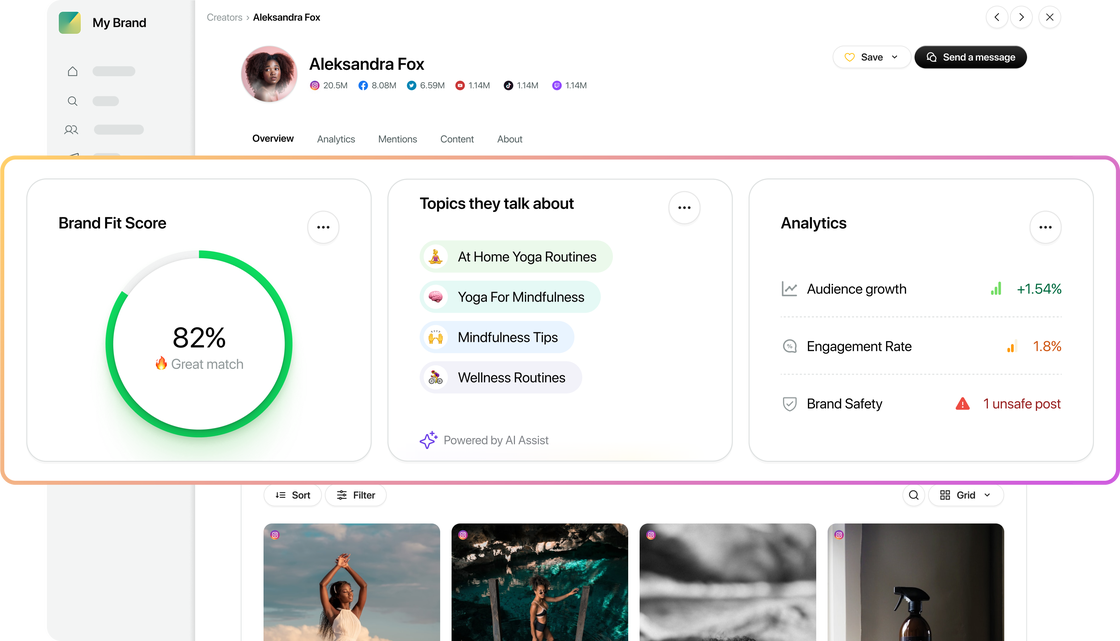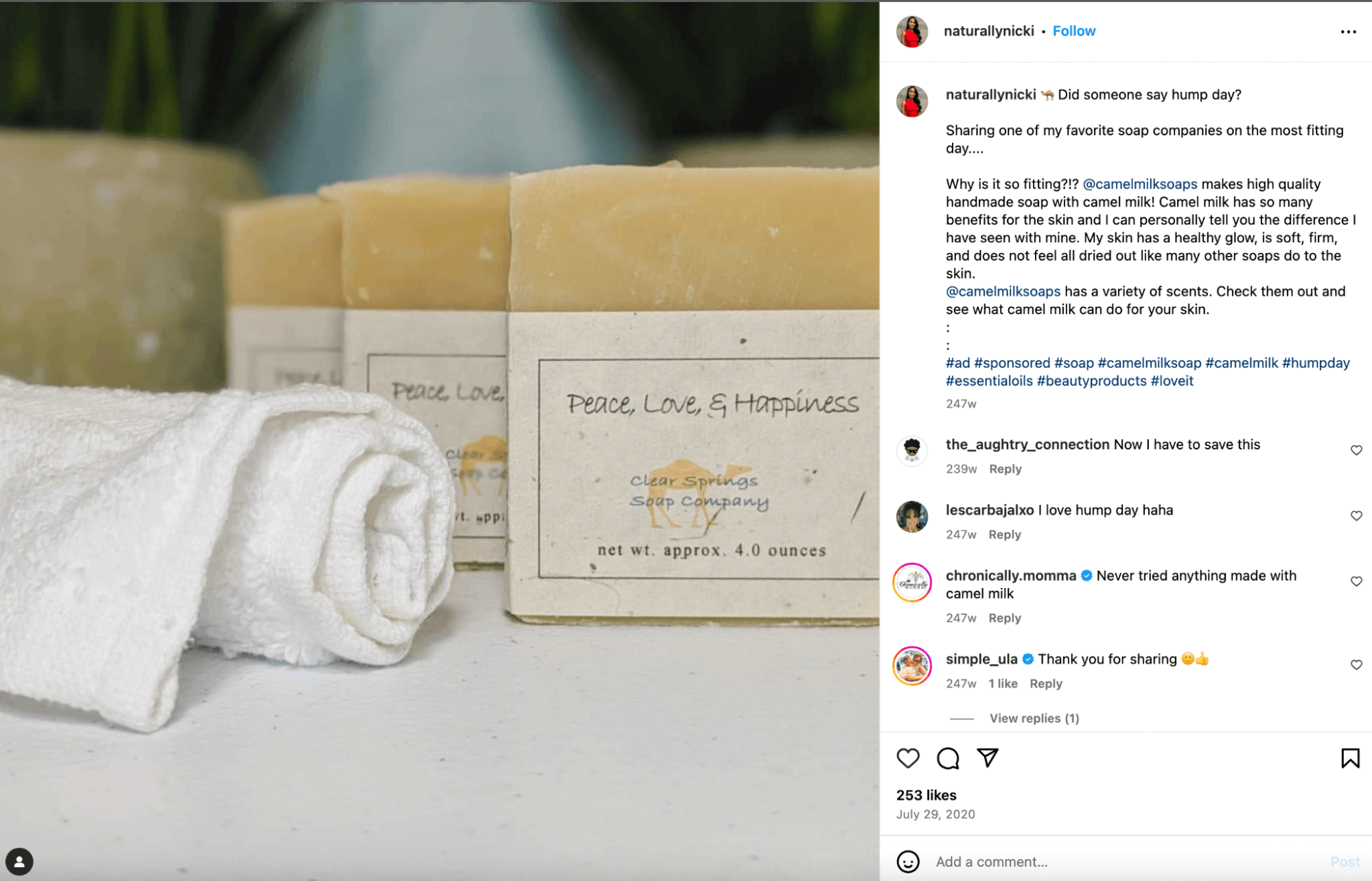Influencer rate card tips for smarter campaign planning

Table of Contents
Influencer marketing is a proven driver of social media growth. Why? Audiences connect with trusted creators and authentic experiences. As a brand, capitalizing on that connection means developing a well-planned approach.
Yet, critical steps in the planning phase—navigating rates, pricing structures and influencer marketing campaign details—often leave brands unsure where to begin.
Influencer rate cards bring transparency to brand-influencer partnerships. Learn more about rate cards and how your brand can leverage them to improve your overall influencer strategy.
What is an influencer rate card?
An influencer rate card is a document or graphic that outlines the fees an influencer charges for their services. The creator card typically details costs for content types and social media channels. Here’s what you can expect:
- Pricing: How much a post, Instagram Story or video costs
- Platforms: The apps the creator uses and any rate differences
- Metrics: Follower counts, engagement rates and clicks
- Packages: Bundles for multiple posts or collaborations
While creators use influencer rate cards to detail their fees, social media marketing teams can create internal influencer rate sheets to evaluate influencer partnerships.
Why brands should create their own influencer rate cards
Social media marketers juggle several priorities: research, planning, content creation, analytics and much more. With the growing investment in influencer marketing, 26% of brands have dedicated 40% of their marketing budget to influencer partnerships.
This expanded scope (managing creator relationships, campaign planning, etc.), combined with major investments, makes tying your campaigns to ROI and business outcomes more crucial than ever. According to the 2025 Sprout Social Index™, 65% of marketing leaders say this tie-in is vital for securing social media investment.
Brands can create internal influencer rate cards to establish clarity and control over their influencer marketing budgets. Here’s how:
- Negotiation: Use your influencer rate card process to establish clear, fair terms with creators.
- Transparency: Ensure consistent expectations for all campaigns.
- Budget: Manage your budget and plan with influencer-specific rate cards.
- Rate comparison: Review and consistently reevaluate rates based on individual creator performance, influencer ROI and market pricing.
What to include in your brand’s influencer rate card
A creator’s influencer rate card focuses on pricing, their metrics and what value they offer to brand campaigns. But your brand’s influencer rate card should focus on evaluating how a creator can contribute to specific business goals.
To create an effective internal rate card, include the following information:
Influencer name and bio
Each influencer rate card should include at-a-glance details about the creator. Add their name, bio and interests. It’ll keep you organized and provide more context on the influencer.
Use this process as an opportunity to analyze their bio, background information and other key metrics to verify creator-brand alignment. Sprout Social’s Influencer Marketing solution can simplify this evaluation, helping you establish if a creator is a good match for your brand based on influencer metrics, brand fit scoring, brand risk and their audience.

Niche and target audience
It’s all in the name: influencers influence their followers to make decisions. But if you hire an influencer whose audience doesn’t match your target audience, you risk misaligning your budget with the ROI you need. For example, if you want to promote a travel product to a luxury audience, partner with a content creator who caters to that audience.
Influencer rating cards should offer strategic insights. For each creator, add their niche, target audience and key attributes or interests that resonate with their followers. When you have a new product or specific campaign, you can quickly spot which influencers are a perfect match.
Service requests
Include the types of content and services you expect from your creator to find the right match quickly. Think of services like:
- Static images
- Videos
- Stories
- Reels
- Brand collaborations (like skits, giveaways or unboxing product reviews)
In the post below, an influencer shares a sponsored static image for a soap brand:
Payment terms and key clauses
Set payment expectations upfront to build trust and avoid confusion. Terms can include payments based on post type, followers, engagement and more (more on this later). By incorporating clarity and transparency, you’re more likely to cultivate positive, long-term relationships with influencers.
As you negotiate the influencer contract, clarify essential terms like usage rights and exclusivity clauses. Do you want to be the only brand your creator promotes in your industry? And how long can you promote (or repurpose) content from the creator? Documenting expectations shields you from any confusion and potential legal issues down the line.
Core social media networks
Rate cards are your go-to resource for streamlining your planning, helping you organize and consolidate critical details, like the top social media channels an influencer works with.
They might be popular on Instagram, and that’s why you want to partner with them—but their follower count might be growing on TikTok and X (formerly Twitter). This insight makes them potential candidates for future campaigns on other social networks, eliminating the need to find new influencers.
6 best practices for establishing influencer rates as a brand
Many factors contribute to influencer rates, like influencer pricing, follower count, country or location and exclusivity. With nearly half of consumers (49%) making purchases based on influencer recommendations, according to the 2024 Influencer Marketing Report, your marketing strategy needs to be aligned for ROI.
Here are some best practices to help you determine your influencer marketing budget:
1. Understand pricing models
There are several approaches to influencer marketing campaign pricing, and you’ll also encounter specific pricing packages set by the influencers you engage.
Here are some pricing models you can use:
- Per post: Pay a flat fee for influencers publishing a post. This is a good option for budgeting, testing new partnerships and increasing brand awareness.
- Per view: Compensate based on the number of views a sponsored post gets. This is an effective option to expand audience reach and motivate creators to boost views.
- Per follower: Calculate rates based on followers or subscribers. This helps you quickly estimate prices beforehand and is also helpful for measuring reach. (Review influencers’ engagement to make sure follower counts translate to activity.)
- Per click: Try a win-win model that pays influencers per click so you can tie results to business goals.
- Per lead: Pay influencers for each qualified lead. This model is effective for high-ticket products and services, where payments per lead may be higher for the creator.
- Per conversion: Compensate influencers per sale or other desired action, like a signup or form fill.
Sprout Influencer Marketing empowers you to cut through the complexity of compensation models, delivering clear insights into individual influencer metrics within your campaigns, regardless of how you structure payment. By providing AI-driven insights, you can accurately measure ROI and understand the specific value each creator delivers. Whether you’re paying per post or conversion, you always have clear visibility into your campaign’s effectiveness.

2. Build a pricing formula
Create a baseline formula to streamline your influencer outreach and speed up your process.
For example, you might use a pricing formula such as $100 per 10,000 followers for images, with a 20% increase for video content. Establish baselines to measure ROI using key performance indicators (KPIs) as you refine your strategy and influencer rates.

Keep reading to get a breakdown of starter rates for each platform.
3. Consider non-monetary compensation
Non-monetary compensation, like gifting or seeding, can be powerful approaches, especially for nano- or micro-influencers eager to grow their following. The key is to set transparent goals and clear expectations with each strategy.
Here are two ways to start exploring non-monetary compensation:
- Influencer gifting: Gifting means sending your product to a creator with no expectation of content creation. Your primary goals are to make a strong impression, establish brand awareness and build relationships. A positive gifting experience can evolve into a seeding opportunity.
- Influencer seeding: Seeding is a strategic test. You provide a product or service as a test—but don’t make an outright ask for content. Instead, you pay attention. You see how the creator responds and monitor how any posts perform. If all goes well, that’s a green light for a formal, paid brand partnership.
Some influencers, especially those just starting out, may prefer exposure and increased engagement. Always listen to what the creator wants and expects from your brand to ensure a mutually beneficial partnership.

4. Consider the engagement rate
While follower counts reveal vital insights, such as potential reach and awareness, engagement rates provide a more accurate sense of impact. Engagement rate measures users’ interactions with posts (likes, comments and shares), which directly contribute to higher ROI.
It’s best to adjust your brand’s rates based on these engagement measures since they offer more realistic and reliable expectations.
5. Be ready to negotiate
Negotiate a campaign that fits your goals and budget, based on an influencer’s experience, previous results and influencer pricing card. These insights, along with past deals and industry benchmarks, can empower your negotiation.
Here are some packages that provide more flexibility in your budget:
- Long-term partnerships: With influencers you’ve established strong relationships with, discuss longer deals that offer cost savings for you and consistent work for the creator.
- Multi-post packages: Negotiate a bulk package for multiple posts to secure a budget-friendly rate per post.
- Content repurposing: If you plan on using the content in different ways in the future, like YouTube Shorts or Reels, make repurposing the influencer’s content part of the terms.
6. Be transparent
Whether it’s about pricing or expectations, it’s better to overcommunicate than assume mutual understanding. Put key terms in writing—like usage rights, exclusivity rights, budgets and key metrics—and leave an open line of communication to build a strong, long-term relationship.
To establish transparent expectations, proactively define and share your SMART goals. Here are some examples:
- Specific: You have a clear business objective, like increasing reach or getting clicks.
- Measurable: You and the influencer know which metrics, like engagement or views, determine success.
- Achievable: Your team determines that the goal is reasonable based on industry benchmarks and past campaign performance.
- Relevant: Your goals and objectives align with your company’s marketing objectives.
- Time-bound: Your goal includes a clear start and end date, a timeline for content posting and specifies the period for measuring results.
Average influencer rates by platform
Choosing the right social media channels for your influencer marketing campaigns isn’t just about chasing platform popularity. It’s about understanding where your target audience engages and how each network’s unique culture aligns with your brand.
To maximize campaign effectiveness and make data-driven decisions, Sprout Influencer Marketing empowers you to quickly identify high-performing networks and creators by analyzing real-time engagement data and potential ROI.
While the following industry averages provide a helpful starting point for budgeting, remember that true value comes from understanding individual influencer performance and audience engagement.
Here are standard influencer rates by social media channels:
Instagram influencer rates
For Instagram posts, a best practice is to start with $10 per post per 1,000 followers. Expect higher prices for Reels or videos because of their complex formats and campaigns.
TikTok influencer rates
TikTok posts usually start at $10 per post per 1,000 followers. Its powerful algorithm provides robust discovery and reach. It’s great for creative projects and viral content.
YouTube influencer rates
YouTube influencer starting rates are about $20 per 1,000 subscribers. Expect higher rates for longer YouTube videos or more in-depth product features.
Facebook influencer rates
Facebook posts typically start at $20 per 1,000 followers. As the world’s largest social network, Facebook is a solid option for awareness and reach campaigns. It also offers strong appeal to older adults, making it an ideal choice for brands targeting that demographic.
X influencer rates
X posts typically start at $2 per post per 1,000 followers. This channel is particularly effective for brands focused on industry thought leadership or tech audiences.
Snapchat influencer rates
Expect a starting rate of $10 per post on Snapchat for every 1,000 followers. This channel is a good option for engaging younger audiences and delivering highly engaging content.

Running an influencer marketing campaign with clear ROI using Sprout Social
While influencer rate cards provide clarity and transparency for campaign budgeting, building successful influencer marketing plans extends far beyond pricing. It involves identifying creators that align with your brand and target audience. You’ll also need to nurture these relationships, manage payments and report on ROI to achieve business goals.
Sprout’s Influencer Marketing solution delivers the management, discovery and reporting capabilities you need to lead a successful influencer campaign and prove ROI.
Track influencer performance and gain control of your influencer campaigns across all your social media channels—all in one unified interface. Schedule a demo today.





Share